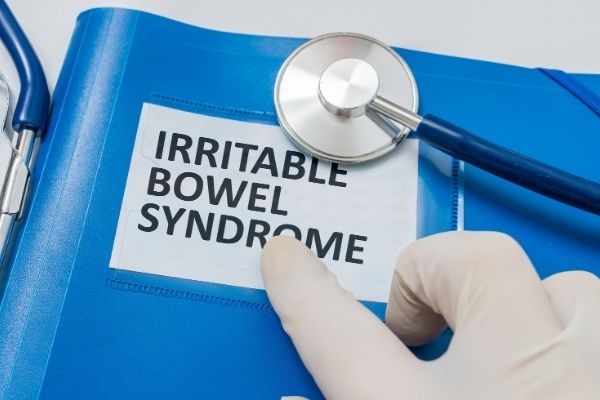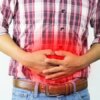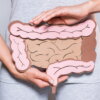
What is the best treatment for IBS with diarrhoea?
As with every digestive issue, there is an imbalance in the gut. Symptoms of IBS-D (irritable bowel syndrome with diarrhoea) are no different.
The treatment for these IBS symptoms greatly depends on the cause of this bowel disorder.
IBS (irritable bowel syndrome) is not diagnosed from blood tests or stool samples. Its diagnosis is based purely on symptoms.

ROME IV Criteria for IBS
The Rome IV Criteria for IBS are as follows:
“Recurrent abdominal pain lasting, on average, at least 1 day per week in the last 3 months, associated with two or more of the following criteria:
- Related to defecation
- Associated with a change in the frequency of stool
- Associate with a change in the form (appearance) of stool” [Source: Pubmed]
While these symptoms may indicate what the bowel is doing, it’s not offering any insight into why it’s doing it.
This is why many conventional options for IBS treatment can be very generic and not offer a deeper insight into the causes of the symptoms. [Source: Pubmed]
How do I stop IBS diarrhoea?
When addressing diarrhea (or any symptom of IBS) it’s not the diarrhoea we are simply looking to stop.
It’s not uncommon for people with loose bowel movements to be prescribed Imodium [Source: Pubmed] While this can be helpful to stop the bowel overactivity, it is working to manage symptoms, not address the underlying issue.
Symptoms of IBS-D
The common factor of IBS is abdominal pain that improves following a bowel movement. This also encompasses the change in frequency and form of the stool.
Based on the form of the stool, an IBS subtype is assigned.
- IBS-C – Irritable bowel syndrome with constipation
- IBS-D – Irritable bowel syndrome with diarrhea
- IBS-M – Irritable bowel syndrome with mixed bowel movements (constipation and diarrhea) [Source: Pubmed]
Causes of IBS, Gut Health Issues and abdominal pain
When considering the causes of IBS-D, there are several aspects to consider. In particular, how and when the symptoms began.
It’s not uncommon for symptoms of IBS to begin after certain triggering events which may lead to changes along the digestive system. Understanding the imbalance in the gut can lead to the most appropriate treatment.
Common causes of IBS-D include:
- Lactose intolerance
- Fructose intolerance
- SIBO
- Post infectious IBS [Source: ASGE]
IBS diarrhoea after eating
A common time for the diarrhoea to be triggered is shortly after a meal. Indicators as to what may be causing this may be found on the plate.
For example, lactose or fructose rich foods may cause an urgent bowel movement in some people. In a similar manner, a wider range of plant fibres triggering bowel movements and a bacterial overgrowth in the small bowel, known as SIBO, may be present.
Additionally, very similar symptoms can be present following a gastric infection or travellers’ diarrhoea.
Even though the symptoms for these may be the same, the treatment may be very different. [Source: Pubmed]
Treatment of diarrhoea predominant IBS
In certain people lactose intolerance may be the issue. However, when assessing this, there are some conditions.
Research indicates that the genetic heritage of the individual influences their ability to adequately digest lactose. For example, those of East Asian heritage appear to have a 70-100% reduced ability to produce the lactose digesting enzyme.
If this enzyme deficiency is the issue that simply removing the lactose containing foods may be adequate. [Source: Medline]
However, as with fructose intolerance, lactose intolerance may offer a deeper insight into the causes of IBS-D and help to guide treatment.
This may be particularly true if the intolerance to these foods began following a triggering event such as food poisoning or antibiotics. [Source: Mayo Clinic]
These can lead the treatment to be based around the mechanisms in the small bowel that are leading to increased bowel frequency and a looser form.
Both antibiotics and food poisoning are known risk factors for SIBO. This is due to their ability to:
- Lead to low-grade inflammation in the bowel
- Change the bacterial balance in the intestines
- Change the sensitivity of the nerves along the gut lining
This can result in a treatment involving methods of rebalancing these 3 elements to improve and resolve IBS-D symptoms. [Source: Pubmed]

Clinical trials
Specific therapeutic substances have been shown to help improve these symptoms.
2 particularly useful tools that can be used are probiotics and prebiotics. Specific strains of bacteria, such as Lactobacillus rhamnosus GG have been shown to improve overall symptoms of IBS. [Source: Pubmed]
The same is also true to prebiotic fibres. With a specific fibre known as PHGG, improving bowel function. Interestingly this can also be helpful in IBS-C as it feeds key organisms in the gut microbiome who regulate the entire environment. [Source: Genesis]
How do you treat diarrhoea with dominant IBS?
The treatment for IBS with diarrhoea depends on the underlying health issues within the digestive system. While IBS can describe a set of symptoms that include pain and changes in stool form and function, the root cause may differ between individuals, even if the symptoms are the same.
These root causes can include:
- Dysbiosis (alterations in the balance of the gut microbiome)
- SIBO (an overgrowth of bacteria in the small intestine)
- Visceral hypersensitivity (nerve sensitivity in the gut)
- Food sensitivities
- Low-grade inflammation
- Stress [Source: Pubmed]
SIBO (small intestinal bacterial overgrowth) has been identified as the root cause in up to 78% of those with IBS with the diarrhoea predominant sub-type. Testing for SIBO is a key area of focus which can guide treatment. [Source: Pubmed]
2 of the main symptoms of IBS are bloating and abdominal pain, this can be due to the increased fermentation in the small intestine seen in SIBO. Commonly this may lead to diarrhoea or an urgent bowel movement within a short space of time after eating trigger foods. This can be due to the osmotic impact of an altered fermentation process.
Identifying food triggers can also be a helpful way of improving symptoms and common dietary approaches that can be considered for a trial period of time as an elimination process (generally between 2-4 weeks) include:
- Gluten-free diet
- Lactose-free diet
- Low FODMAP diet
- Fructose-free diet [Source: Pubmed]
SIBO and IBS with diarrhoea
SIBO (small intestinal bacteria overgrowth) is where an increase of bacteria in the small intestine if noted. An overgrowth of bacteria in this part of the GI tract can lead to a range of symptoms.
While these IBS symptoms may change between individuals and require different types of care to manage symptoms, addressing the underlying cause of the increased transit time seen in IBS-D and imbalances in the GI tract are important for a successful treatment.
It is common for certain foods to trigger IBS symptoms. Therefore, dietary approaches such as the low FODMAP diet can be a very helpful way to manage and improve symptoms. Alongside this, therapeutic agents (for example supplements or medications) can be considered to support the microbial balance of the small intestine.
While anti-microbial therapy, either with antibiotics (such as Rifaximin) or antimicrobial herbs (such as oregano and garlic) can be considered as a form of treatment for SIBO, studies have also found that probiotics can address SIBO.
Rather taken probiotics than simply adding more bacteria to the gut, these transient organisms taken in capsule form can work to support the individual’s own immune system in the upper GI tract (the small intestine). This results in a stimulation of the gut’s own anti-microbial processes, resulting in a reduced bacterial load as well as an improvement in digestive symptoms such as discomfort, pain, bloating and diarrhoea. [Source: Pubmed]
For those with SIBO who have been prescribed antibiotics as a treatment, this can be successful. However, it is also possible for SIBO to reoccur and for a repeat treatment to be required. This can also involve additional support, treatment and care to consider additional causes of conditions. This information can depend on the individual and their personal cases.
These causes can include:
Anatomical
- Small intestine diverticula
- Small intestine strictures (radiation, medications, Crohn’s disease)
- Surgically created blind loops
- Resection of the ileocecal valve
- Fistulas between proximal and distal bowel
- Gastric resection
Motility Disorders
- Gastroparesis
- Small bowel dysmotility
- Celiac disease
Metabolic Disorders
- Diabetes
- Hypochlorhydria
Organ System Dysfunction
- Cirrhosis
- Renal failure
- Pancreatitis
- Immunodeficiency states
- Crohn’s disease
- Celiac disease
Medications
- Recurrent antibiotics
- Gastric acid suppression [Source: Pubmed]
Low FODMAP Diet for IBS with Diarrhoea
The low FODMAP diet is a clinically researched approach to reduce symptoms of IBS such as bloating, and abdominal pain as well as improve bowel form and function. This has shown the most benefit in the IBS-D subtype of IBS.
This diet reduces the consumption of certain carbohydrates found in a range of foods, that are poorly absorbed in the small intestine and fermented in the large intestine. If there are imbalances in the gut, for example, alterations in the balance of the gut bacteria in the upper GI tract (small intestine) or the large intestine this can result in alterations in this fermentation process which leads to symptoms.
Common high FODMAP foods avoided on this diet include garlic, wheat, onions, lactose-containing dairy, legumes, beans, cabbage, cauliflower and apples.
Several studies investigating this diet for IBS patients find improvement in a range of digestive and non-digestive symptoms.
These include:
- Reduced abdominal pain
- Improved stool consistency
- Improved quality of life
- Reduced anxiety and depression
- Improved sleep
- A reduction in fatigue
For a more in-depth review of this diet click here.
Lifestyle and home remedies alternative medicine
As healthy foods can trigger bowel movements keeping a 7-day food and symptom diary can help identify any potentially problematic foods. However, I do not suggest keeping endless food diary looking for the perfect restricted diet.
If there are several foods that may be impacting symptoms, it may be that there is an imbalance that needs treating.
3 foundational aspects that can be helpful to support the foundational aspects of digestive and improve symptoms of IBS-D are:
- Meal spacing – leaving 3 – 4 hours between meals can help the digestive processes by encouraging the cleaning wave known as the MMC sweep through the gut. This help to regulate the bacterial balance.
- Chewing – chewing each mouthful 30 times can support overall digestive health and trigger digestive enzyme release.
- Breathing practices – simply breathing exercises, such as diaphragmatic breathing, can help support and calm the central nervous system. In some people an overactive central nervous system may contribute to altered bowel patterns. [Source: CCJM]
If you have IBS you may also be experiencing bloating. To learn more about bloating and how to tackle it, download our free eBook How to beat the bloat – here.






